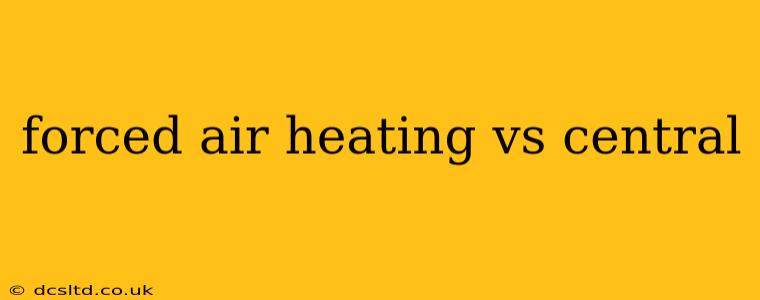Forced Air Heating vs. Central Heating: Which System is Right for You?
Choosing the right heating system for your home is a crucial decision impacting comfort, energy efficiency, and long-term costs. Two dominant options often top the list: forced-air heating and central heating systems. While both aim to warm your home, they achieve this through different methods, each with its own set of advantages and disadvantages. This comprehensive guide will delve into the key differences, helping you make an informed choice.
What is Forced Air Heating?
Forced-air heating systems utilize a furnace to heat air, which is then circulated throughout your home via a network of ducts. A blower motor pushes the warm air through these ducts and vents, distributing heat to different rooms. This is the most common type of heating system found in North American homes due to its relatively low initial cost and adaptability to various home designs.
What is Central Heating?
The term "central heating" is broader, encompassing several heating methods that centrally generate heat and distribute it throughout the house. This often includes systems like hydronic (hot water) radiant heating, electric baseboard heating, and geothermal heating. These systems generally differ from forced-air in their heat distribution method – often utilizing radiators, in-floor tubing, or baseboard units instead of air ducts.
Forced Air Heating Pros & Cons
Pros:
- Cost-effective: Generally less expensive to install than other central heating systems.
- Versatile: Easily adaptable to most home layouts.
- Air conditioning integration: Often integrated with central air conditioning systems, providing year-round climate control.
- Improved Indoor Air Quality (with additions): Some forced-air systems can be enhanced with air purifiers and humidifiers to improve indoor air quality.
Cons:
- Uneven heating: Can lead to temperature inconsistencies between rooms due to ductwork issues or air leaks.
- Dust and allergen circulation: Distributes dust and allergens throughout the home unless equipped with proper filtration.
- Higher energy consumption: Can be less energy-efficient than some other central heating options, particularly hydronic systems.
- Ductwork maintenance: Requires regular maintenance to address leaks, clogs, and potential mold growth.
Central Heating (Hydronic/Radiant) Pros & Cons
Pros:
- Even heating: Provides consistent temperatures throughout the house.
- Quieter operation: Generally quieter than forced-air systems.
- Energy-efficient: Can be more energy-efficient than forced air, particularly radiant floor heating.
- Improved comfort: Radiant heat provides a comfortable, even warmth often perceived as more pleasant.
Cons:
- Higher installation costs: Typically more expensive to install than forced-air systems.
- More complex installation: Requires more specialized labor for installation.
- Less adaptable: Can be more challenging to retrofit into existing homes.
- Potential for leaks: Hydronic systems are susceptible to leaks, requiring timely repair.
Which System is More Energy Efficient?
While it's a common misconception that all central heating systems are inherently more efficient, the truth is more nuanced. A well-maintained and properly insulated forced-air system can be reasonably efficient. However, hydronic (especially radiant) heating systems generally boast higher energy efficiency ratings due to their ability to use lower temperatures to achieve the same level of warmth. The efficiency of either system heavily depends on factors like proper installation, insulation, and regular maintenance.
What are the Maintenance Requirements for Each System?
Both systems require regular maintenance. Forced-air systems necessitate annual furnace inspections, filter changes, and duct cleaning to maintain efficiency and prevent issues. Hydronic systems require regular pressure checks, flushing, and occasional component replacements. Ignoring maintenance in either system can lead to reduced efficiency, higher energy bills, and premature equipment failure.
What is the Typical Lifespan of Each System?
The lifespan of both systems depends largely on maintenance and usage. A well-maintained forced-air furnace can last 15-20 years, while a hydronic system can last even longer, potentially 20-30 years or more.
Which System is Better for Allergies?
For allergy sufferers, hydronic systems generally offer a cleaner environment as they don't circulate dust and allergens through the air ducts like forced-air systems. However, a properly maintained forced-air system equipped with a high-efficiency air filter and regular duct cleaning can mitigate this issue considerably.
Ultimately, the best heating system for your home depends on your budget, home design, energy efficiency goals, and personal preferences. Consulting with a qualified HVAC professional is crucial for determining the most suitable and cost-effective option for your specific needs.
